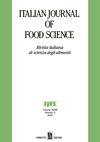The virgin coconut oil (VCO) emulsion powder characteristics: effect of pickering emulsion with microcrystalline cellulose (MCC) and different drying techniques
IF 3.3
4区 农林科学
Q2 FOOD SCIENCE & TECHNOLOGY
引用次数: 4
Abstract
Virgin coconut oil (VCO) has many health benefits; however, drinking of VCO directly is still uncommon. In order to overcome this problem, microencapsulation can be one of the solutions. Unfortunately, emulsion is an unstable system and rapidly separates into two layers. Therefore, in this study, we carried out the explanatory research of microencapsulation process with descriptive analysis. It comprised two emulsion treatments, using homogenization method, and three drying techniques, to determine the effect of Pickering emulsion with microcrystalline cellulose (MCC) and different drying techniques on the characteristics of VCO powder (before drying: creaming index and emulsion droplet size; and after drying: drying yield, color intensity, moisture content, particle morphology, microencapsulation efficiency, peroxide value, rehydration particle size, and dissolving time). The results demonstrated that all emulsion treatments did not depict any emulsion instability up to 21 days of storage, and the obtained VCO powders had different characteristics. The highest microencapsulation efficiency was 33.49±1.59%, obtained from the emulsion using Tween 80 and MCC by spray drying, and the lowest peroxide value was 0.464±0.084 mEq O2/kg, obtained from the emulsion using Tween 80 and MCC by vacuum drying. The future application of this study is expected to produce VCO powder that can improve the ease handling of VCO and also commercialize for being used as a non-dairy creamer.初榨椰子油(VCO)乳剂粉体特性:微晶纤维素(MCC)对乳剂酸洗的影响及不同干燥工艺
初榨椰子油(VCO)有很多健康益处;然而,直接饮用VCO仍然不常见。为了克服这个问题,微胶囊化可以成为解决方案之一。不幸的是,乳剂是一种不稳定的体系,会迅速分成两层。因此,在本研究中,我们采用描述性分析的方法对微胶囊化过程进行解释性研究。采用均质法和三种干燥技术对含微晶纤维素(MCC)的皮克林乳液进行处理,研究不同干燥技术对VCO粉体特性的影响(干燥前:成乳指数和乳滴大小;干燥后:干燥得率、显色强度、含水率、颗粒形态、微胶囊化效率、过氧化值、再水化粒度、溶解时间)。结果表明,在21天的贮藏时间内,所有的乳化处理均未出现乳化不稳定性,得到的VCO粉体具有不同的特性。喷雾干燥Tween 80和MCC制备的微囊化效率最高,为33.49±1.59%;真空干燥Tween 80和MCC制备的微囊化效率最低,为0.464±0.084 mEq O2/kg。本研究的未来应用有望生产出VCO粉,提高VCO的易处理性,并作为非乳制品奶精商业化使用。
本文章由计算机程序翻译,如有差异,请以英文原文为准。
求助全文
约1分钟内获得全文
求助全文
来源期刊

Italian Journal of Food Science
工程技术-食品科技
CiteScore
4.20
自引率
0.00%
发文量
33
审稿时长
>36 weeks
期刊介绍:
"Italian Journal of Food Science" is an international journal publishing original, basic and applied papers, reviews, short communications, surveys and opinions on food science and technology with specific reference to the Mediterranean Region. Its expanded scope includes food production, food engineering, food management, food quality, shelf-life, consumer acceptance of foodstuffs, food safety and nutrition, energy and environmental aspects of food processing on the whole life cycle.
Reviews and surveys on specific topics relevant to the advance of the Mediterranean food industry are particularly welcome.
 求助内容:
求助内容: 应助结果提醒方式:
应助结果提醒方式:


